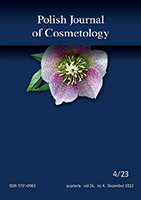search by
Copyright @ Pol J CosmetolContemporary methods of treatment and masking of skin lesions in people with vitiligoKlaudia Drab, Magdalena Górska Krakowska Wyższa Szkoła Promocji Zdrowia z siedzibą w Krakowie Summary Vitiligo affects 1-2% of the human population with the same incidence in women as in men. It most often begins before the age of 20 and in most cases stays for the remaining years, although spontaneous recession of the disease has been observed in some patients. It manifests as depigmented patches, usually arising in areas particularly exposed to sunlight. The etiopathogenesis is not fully understood, but there are several theories of lesion formation, including immunologic, neurogenic, cytotoxic, genetic, and viral. Three main forms of vitiligo are found in the literature: segmental, non-segmental, and unclassified. The first one is characterized by the presence of discoloration on one half of the body. The second type includes all lesions that cannot be classified as segmental and spots that are observed on a larger area of the body. The unclassified type, on the other hand, mentions the focal form, which distinguishes depigmented areas that do not fall into the previous two forms, and the mucous membrane form, where a maximum of one lesion is observed. Vitiligo is treated on several levels. Topical treatments include glucocorticosteroids, calcineurin inhibitors, and vitamin D3 analogs (for small lesion areas). When the spots cover more than 10-20% of the body surface phototherapy is used. This is divided into PUVA and NB-UVB therapy. Treatment using excimer laser is used when the lesions occupy less than 30% of the body surface. A surgical method, epidermal grafting, is also used. Since no method can guarantee repigmentation it is necessary to mask the affected areas with cosmetics with high pigment content with a high content of pigment. Key words: vitiligo, skin lesions, phototherapy, laser therapy, cosmetology |




